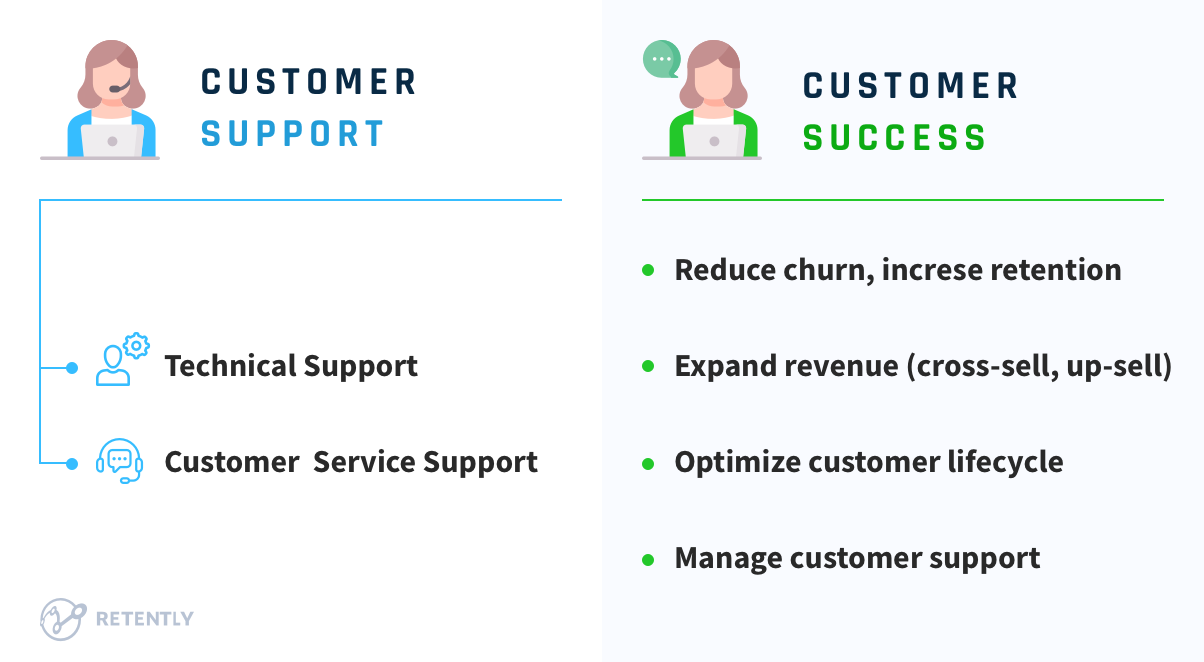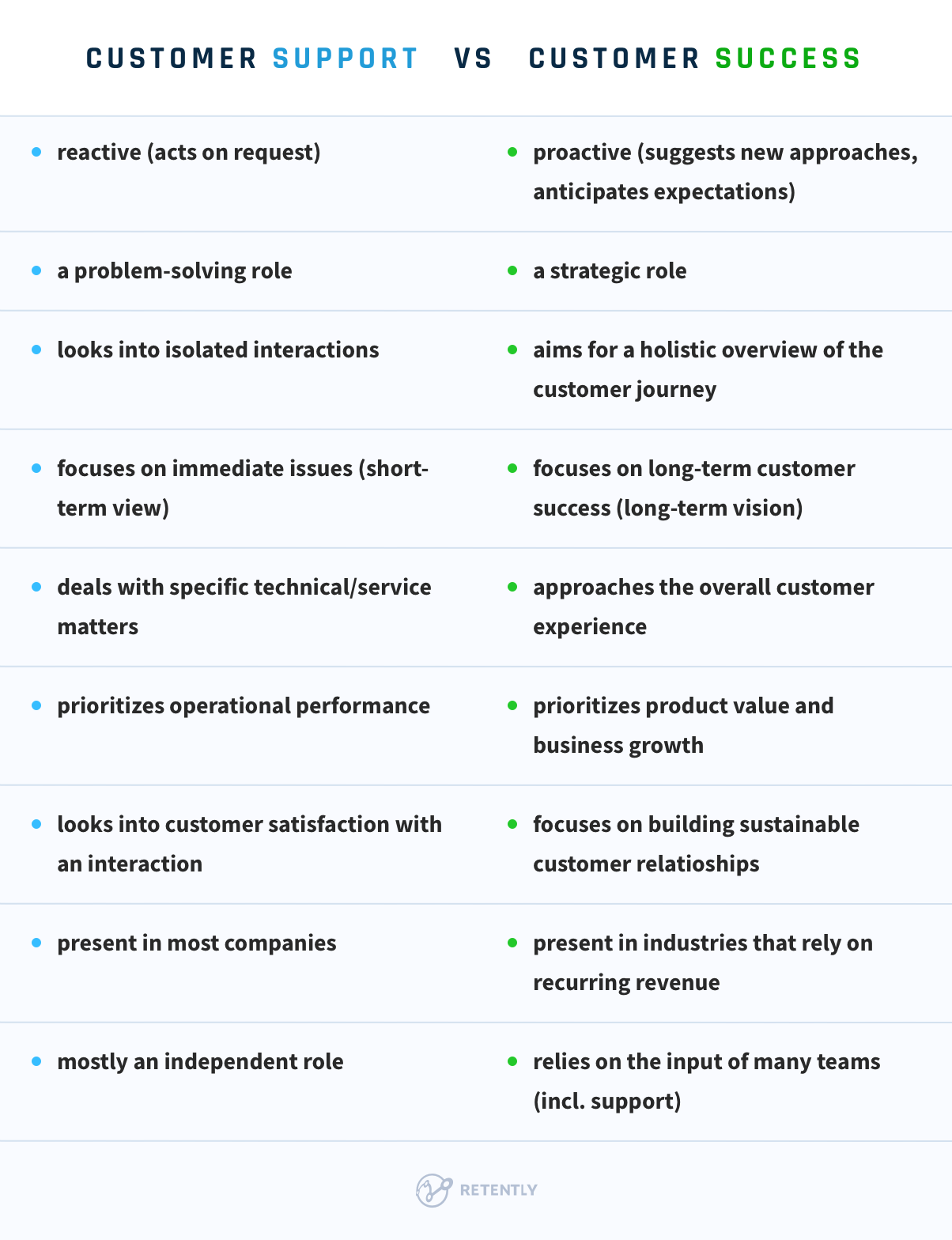With new SaaS companies popping up daily and a customer-centric culture coming into play, there’s (understandably) some confusion about how to manage customer interactions.
For many companies, the entire conversation takes place under the umbrella of Customer Support (or Technical Support). Some companies have separated these functions further and appointed specialized groups for Onboarding, Implementation, and Customer Education. But there’s still one area that’s neglected all too often – Customer Success.
As SaaS companies spring up, the essential Customer Success role is being rolled into Customer Service. It seems that many of these new companies are struggling to define what Customer Success means and how their agents (Customer Success Managers) should operate.
So, let’s shed some light on the real difference between Customer Success and Customer Support roles, and why these should be viewed as independent disciplines rather than interchangeable terms.
What is the role of Customer Success?
SaaS companies were the early adopters of Customer Success, as customer retention started to become a real challenge. Reducing customer churn, expanding customer relationships post-sale, and focusing on the delivered value became the top priorities, which led to the need for a new customer management practice.
The Customer Success Manager (CSM) is thus not a passive role. Unlike a traditional Customer Support scenario (where the customer calls for help and advice), a CSM’s goal is long-term success for their customers.
CSMs must actively seek ways to help customers make the most of a company’s SaaS offering. They need to tap into customer needs, predict and shape their behavior, to be able to guide their way to the desired outcome. In doing so, they become long-term advocates for their customers.
From a business perspective, Customer Success is a strategic role, acting as a growth driver towards:
- increased customer lifetime value
- reduced customer churn
- increased cross-sell and up-sell opportunities
- optimized customer touchpoints
- building advocacy
Customer Success professionals strongly rely on data (be it engagement, product adoption, CRM, or survey data) and smart automation to constantly track customer health, in order to be one step ahead of expectations and one step closer to an outstanding end-to-end customer experience. Actually, an Aberdeen study reveals that data-driven Customer Success programs have a 93% greater annual improvement in customer retention and a 94% annual improvement in Net Promoter Score®.
This is very different from the much more reactive position of a Customer Support representative.
What Customer Support actually means
Although both roles have the customer at heart, Customer Support is more of a problem-solving department than a long-term success strategy. In this role, support reps primarily respond to two scenarios:
- Technical Support
Often, this doesn’t mean solving all technical issues with a SaaS product. In many cases, a rep will escalate an issue if they are out of their depth. However, it’s important to understand that Customer Support is the first responder to all technical issues. They respond to technical questions as they come in. - Customer Service Support
The second (and perhaps most important) function of the Customer Support representative is to solve customer issues. This could be a question about a purchase, billing, or account options, as well as complaints.

Hence, Customer Support has a more transactional nature, focusing on specific interactions rather than long-term customer relationships and overall perception of the brand. Instead, Customer Success is aiming to get a more holistic overview of the customer journey and build on existing relations through consistency.
Given the complexity of the Customer Success role, these reps must have a 360-degree customer view, infusing knowledge of Support, Product, Marketing and Sales. So, it’s no surprise that 51,9% of CSMs advance to leadership roles.
So why all the confusion?
Admittedly, both roles are related. They both deal with a customer’s interaction with a SaaS product and aim to deliver an amazing customer experience. They rely on specific KPIs and customer satisfaction metrics (CES and CSAT are especially relevant for Customer Support, while NPS provides a broader picture to Customer Success) to always keep track of outcomes and share data across teams.
Both roles are also externally-facing, in some cases, they may be the only employees a customer meets in a SaaS company. But that’s where the similarities should end, and here’s why…

Why the two departments must remain separate
By keeping the two departments interchangeable, many organizations find themselves stuck fighting fires instead of building a long-term vision. Here’s what typically happens:
A company will bring on a new customer and solve their issues through their Customer Support department. As time passes, the SaaS company will dedicate more resources to this customer and eventually assign a dedicated representative. The danger is in naming this representative a Customer Success Manager.
As a CSM, the goal is to help a customer realize the full potential of a company’s SaaS product. But by lumping in the Customer Success role with that of Customer Service, representatives are stuck solving problems as they happen. There’s never an opportunity to help customers with the future, as they’re too busy fighting fires in the present!
Where it begins to cost money
The problem of merging both departments can actually impact a firm’s bottom line. Most large SaaS companies offer their clients an option to access premium support. This is a dedicated support rep that comes with an hourly or monthly price tag.
Charging for a dedicated rep makes sense because these employees are solving problems reactively— the client is coming to them and asking for a solution. However, when companies assign a CSM, they are often considered a value-add for new customers. And indeed, they should be. Ideally, a Customer Success Manager is there to work proactively and suggest new ideas or approaches.
But when a firm aligns the role of a CSM with that of a Customer Support rep, they’re performing the same work… for free! It means thousands of dollars in missed revenue every time this is allowed to happen.
Moreover, according to Totango’s State of the Customer Success Industry and Salary Survey, the salaries of Customer Success have kept increasing over the past years as companies place more and more value on this role – a trend that is not expected to step back.
So what’s the solution?
The Customer Success department is still new for many companies. As such, it’s understandable that many firms are still struggling to define what the role entails. Yet, solving this problem quickly is essential to building a strong SaaS business.
Working correctly, a CSM offers massive value to your clients by suggesting better ways to use your SaaS product. By separating them from the break-fix cycle, they’re often forced to assume that you allow them to make these suggestions and stop fighting fires.
The answer lies in distinguishing each department as a separate division. In this way, you can provide a solution to customers’ immediate issues (Support) while still offering value-added advice and long-term vision (Success).
Yet, effectively prioritizing and delivering desired customer outcomes requires identifying and sharing appropriate customer metrics and information across teams. Customer Success is a company-wide project, meaning customer goals and product value must become embedded in your business culture.
Now, if you were to use CX surveys, capturing customer expectations and predicting growth would be much easier. If you’d like to try out CX surveys, we offer a fully integrated solution that comes with a free 7-day trial.






























 Greg Raileanu
Greg Raileanu 


 Alex Bitca
Alex Bitca 


 Christina Sol
Christina Sol